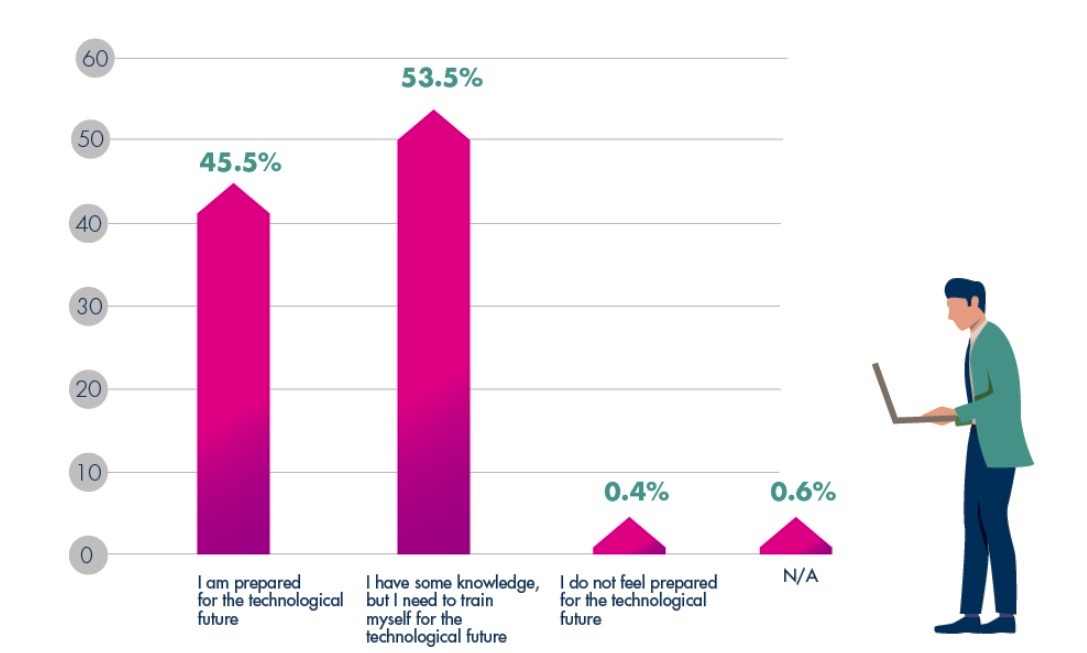Global trends mark that the workforce is diversifying. Faced with the challenges of the future of work, organizations rely on a mixed workforce to provide the necessary human talent.
It is undeniable that the world of work is changing and company executives are fully aware of the need to adapt to this new scenario. With the emergence of artificial intelligence in the business world and the growing automation of processes, machines in the next three years will replace 20% of jobs.
Global trends show that industry 4.0 will generate countless new jobs, which previously did not exist, and the urgency of having skills in strong demand. Furthermore, a context of growing digitalization and connectivity will add the challenge of dealing with the decline in the workforce, caused by a fall in the birth rate and an ageing population. This is an additional factor to the skills gap, which encourages the search for talent anywhere, adopting new forms of hiring.
Labour disruption: challenges to be faced
A recent study by Mercer, Global Talent Trends, found that 73% of executives interviewed expect considerable disruption in the world of work over the next three years. Ninety-nine per cent of companies surveyed say they are taking steps to deal with it.

One of the most complex challenges seems to be the retraining of the current workforce and the search for human talent capable of closing the technological gap in the transition process.At the same time, they point out that critical issues related to human capital harm business productivity:
- Filling vacancies in critical positions takes too long
- A low employee commitment is noted
- A pool of talent whose diversity fails to keep pace with expectations
- Lack of proactive leadership in the change process
- Slow decision-making
- Recruitments that do not meet the desired expectations
How companies are dealing with disruption
In this struggle to manage human talent and mould it to cope with change, Mercer distinguishes four trends:
- Redesigning jobs to align work with future value: the structure of organizations is transforming. Job automation will tend to focus on those jobs that have a direct impact on customers, are more likely to be optimized and develop skills for the future.
- Business brand building: to attract and retain human talent, organizations turn to data science, to create a brand that can attract the talent sought.
- Promote work experience: the aim is to digitize and simplify work to make it more intuitive and encourage employee growth.
- Make employees leaders of change: rethink business growth from a perspective that gives greater prominence to employees. Redesign processes and tasks, migrating to a scheme of greater horizontality, with few hierarchies, based on collaborative work and agile.

New hiring modalities: the freelance universe, on the rise
The need to fill skills gaps is broadening the range of talent search. Mercer states that 79% of executives believe that freelancers or casual workers will increase their participation in the workforce in the coming years. A trend that goes hand in hand with the impressive growth of the freelance labour market worldwide.
In its Global Gig-Economy Index report for the second quarter of 2019, Payoneer shows that this growth is consistent vs 2018. The 10 countries with the highest levels of growth are: USA (78%), UK (59%), Brazil (48%), Pakistan (47%), Ukraine (36%), Philippines (35%), India (29%), Bangladesh (27%), Russia (20%) and Serbia (19%). Brazil’s overwhelming growth seems to be related to a greater diffusion of the Gig economy among the population.
Asia, a new global hub for freelance talent
Asia is becoming a vital hub for talent. Payoneer’s study shows that if you add the profits of freelancers in the last year from Pakistan, the Philippines, India and Bangladesh, the pool increase reaches 138%. In all cases, a decisive factor for this trend has been government investment in digitizing the population and strengthening their technical skills.

It is worth noting the participation of Generation X in this curve: in Pakistan, 70% of the freelancer population is under 30 years old, with an eminently technical background, and 77% of profits come from the segment.
Freelance talent plus clients, a pair that grows
Workana’s 2019 Report provides key data on the desire for constant training in the freelance talent force:
- 70% are university graduates, and 24% are in higher education
- 72% choose to continue their training on digital platforms or e-learning spaces
- Almost 100% of freelancers say they feel ready for the technological future

On the other hand, the report highlights that the majority of customers (70%) have recently stepped into the freelance model. However, 97.4% believe that freelancing will grow considerably in the next five years. For clients, the most valued feature of freelance professionals is their experience, while language does not seem to be a barrier to employment. As for the shaping of the universe of customers:
- Almost 60% of clients are companies
- 30% made up of individuals and a small percentage of NGOs and government agencies
- the areas with the highest order intake were IT and Programming (46.8%), Design and Multimedia (24.8%), Writing and Translation (13.8%) and Marketing and Sales (11.9%).

In 2020, greater strategic planning and a mixed workforce
In its Human Capital Trends 2019 report, Deloitte points out that these platforms and talent networks are snowballing, generating a business of almost 2 billion dollars a year. However, organizations are not taking full advantage of the potential offered by this alternative workforce.
Most companies recognize that they use it to “fill cracks,” but have not developed a strategic plan to capitalize on this resource as a long-term solution. While 54% recognize a lack of consistency in their alternative hiring, the Human Resources area is assuming a more significant role in promoting change. As for Human Resources executives, 75% claim they turn to this model, and 63% have begun to establish benefit schemes for these hiring. Moreover, 51% are developing long-term strategies to optimize this resource, and 22% even plan to apply bonuses or other incentives. The data allow us to conclude that a mixed workforce is emerging, with freelancers actively participating in the process of organizational growth.
The challenges presented by the current technological challenge will lead to an inevitable process of upskilling and reskilling without borders. Hopefully, organizations will choose to meet the needs that arise by literally looking for talent anywhere. In this sense, the Gig Economy, and especially the freelancing, promise to tread heavily.
Global trends show that the company-freelancer relationship will be strengthened through diversified workforces, focused on collaboration and under innovative remuneration schemes.
—
You might also be interested in:
- Digital Transformation: Can remote professionals be the key to taking the next step in your business?
- What HR should take into account when bringing professional freelancers into the company.
- Teamwork: Identifying Each Member’s Potential
- 2020 Trends: How is the ecommerce and retail sector preparing for this new year?





